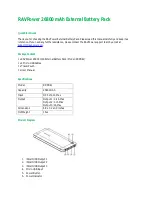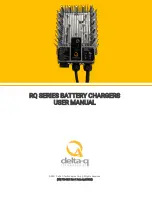
8
hold finger on selection button for 10 or more seconds until LED #3 turns full on.
The program now continues
directly to STEP 4. Remove finger from pushbutton.
STEP 2 & 3 - Battery State of charge & ambient temperature
Battery voltage is measured to determine State Of Charge (SOC) and the initial charge step.
LFP mode: The charge program limits charge current if the temperature measured at the OptiMate is equal or
below 0ºC / 32ºF or above 45ºC / 113ºF. If the temperature was initially below 0ºC / 32ºF charge current is
limited for the first hour after which the battery is expected to have increased its internal temperature.
Pb and LFP charge modes: If the temperature is below -20ºC/-4°F or above 55°C/131°F no charging will be
allowed.
Follow instructions under section 'LED #8 blinking rapidly - ERROR!'.
LED #3 - LOW VOLT SAVE MODE
Pb / LFP selection - Charging starts here for a battery with voltage measuring less than 12.4V if a Pb / lead-acid
battery or 13V if a
LiFePO
4
battery, or if the charger was manually activated. Charging will continue through
steps 4 to 6, during which continuous battery health testing is performed to ensure the battery is safely
recovering. If a problem is detected charging may be suspended and LED #8 will blink rapidly.
Follow
instructions under section 'LED #8 blinking rapidly - ERROR!'.
STEP 4 - SAVE, deep discharged battery below 8.8V. SOC<0%
Pb: Current starts at 200mA and delivered in pulses to determine if the sulphated battery is able accept
charge. Once confirmed charging will continue to STEP 5.
LFP: Current starts at 200mA and will increase as the voltage rises towards 8.8V. A healthy battery should
progress to STEP 5 within 2 hours.
STEP 5 - SAVE, discharged battery 8.8V or higher, able to accept charge. SOC≥0%
Pb: Current is varied between 0.2A and 1.25A, up to a voltage of 14.4V, for a maximum period of 2 hours.
LFP: Maximum current is set to 1.25A. The battery's charge acceptance is monitored for unusual behaviour
such as may be displayed by a battery with a short circuited cell.
STEP 6 - TESTING -
The battery's ability to accept charge normally is monitored through-out STEP 4 and 5. A
final test may be performed as described below. If damage has been detected, charging will be suspended.
Pb: A healthy Pb battery should progress to STEP 7 within two hours, otherwise charging is interrupted for 2
minutes and the battery's ability to hold charge is monitored.
LFP: Once the voltage has risen to 13.1V charging is interrupted and the battery's ability to hold charge is
monitored for 2 minutes.
A healthy battery will progress to STEP 7.
NEW mode: Charging automatically progresses to STEP 7 when the battery voltage reaches 13.1V.
LED #4 - BULK CHARGE
SOC≥50%
Charging starts here: 1) if 60' selection was made, or if no selection was made prior to connecting the battery,
or 2) if Pb or LFP selection was made and the connected battery measures 12.4V or higher for a Pb / lead-acid
battery or 13V or higher for a LiFePO
4
battery.
STEP 7 -
The
ampmatic
™ CHARGE program automatically determines the most efficient rate of charge
current for the connected battery, according to its state of charge, state of health, and electrical storage (Ah)
capacity. The delivered current may be anywhere from 1.25A to 5A (within the safe ambient temperature
environment).
LED #5 - ABSORPTION CHARGE
SOC≥75%
STEP 8 -
Charging continues until 14.4V is reached after which the
ampmatic
™ current control program
delivers pulses of current for a period of 10 minutes, with voltage cycling between 14.1V and 14.4V to equalise
the individual cells within the battery.
NOTE: For safety reasons there is an overall charge time limit of 24 hours up to STEP 8, if exceeded, STEP 9
starts automatically.
60' mode: Charge time limit is shortened to 60 minutes; STEP 9 starts automatically after the battery has
received 1 hour of charge.
LED #6 flashing - VOLTAGE RETENTION TEST
Summary of Contents for Pro4 Duo
Page 2: ...Illustration 1 Ill 1 SW1 AC SW1 1 0 1 on 0 off AC 100 240V 50 60Hz 2 ...
Page 74: ...74 ...
Page 75: ...75 ...









































